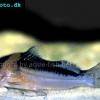Mees’ pimelodid - Brachyrhamdia meesi
Scientific name: Brachyrhamdia meesi
Common name: Mees’ pimelodid
Family: Heptapteridae
Usual size in fish tanks: 8 - 9 cm (3.15 - 3.54 inch)
014
Recommended pH range: 6.4 - 7.3
Recommended water hardness: 3 - 16°N (53.57 - 285.71ppm)
0°C 32°F30°C 86°F
Recommended temperature range: 23 - 27 °C (73.4 - 80.6°F)
The way how these fish reproduce: Spawning
Where the species comes from: South America
Temperament to its own species: peaceful
Temperament toward other fish species: peaceful
Usual place in the tank: Bottom levels
Food and Feeding
The Mees’ Pimelodid (Brachyrhamdia meesi) is an opportunistic omnivore with a hearty appetite, so care must be taken not to overfeed. In the aquarium, they readily accept a wide range of foods, making them relatively easy to feed. Provide a staple diet of high-quality sinking pellets or flakes specifically formulated for bottom-dwelling fish. Twice a week, supplement their diet with protein-rich treats such as live or frozen brine shrimp, bloodworms, or daphnia. Including occasional plant-based foods, such as spirulina wafers or blanched vegetables, ensures a balanced diet and promotes optimal health.
Origin
The Mees’ Pimelodid is native to the freshwater systems of South America, primarily found in the waterways of the Amazon River Basin, including regions of Brazil, Colombia, and Peru. These fish inhabit slow-moving rivers and streams, often in areas with dense vegetation, sandy or muddy substrates, and ample hiding spots.
Sexing
Sexing Brachyrhamdia meesi is challenging, as there are no significant visible differences between males and females. Observing behavior during breeding or examining physical traits during spawning periods may help distinguish the sexes.
Breeding
There are no documented cases of successful breeding of Mees’ Pimelodid in home aquariums. In the wild, they are believed to be egg scatterers, depositing their eggs over substrate or among vegetation without offering parental care. Replicating their natural conditions, such as slightly acidic to neutral water, ample hiding spaces, and soft substrates, may encourage breeding behavior. However, more research and experimentation are needed to understand their reproductive habits fully.
Lifespan
With proper care and optimal water conditions, the Mees’ Pimelodid can live for 5-8 years in captivity. Regular maintenance, a well-balanced diet, and a peaceful environment contribute significantly to their longevity.
Tank Requirements
Mees’ Pimelodid requires a well-maintained aquarium of at least 75 liters (20 gallons) to accommodate their active swimming behavior and need for hiding spaces. They thrive in aquariums with subdued lighting, which can be achieved by using floating plants like Salvinia or Java Moss. A soft sandy substrate is recommended to protect their barbels while foraging, and the addition of driftwood, smooth rocks, or caves provides hiding spots to reduce stress.
Maintain water conditions within a temperature range of 23-27°C (73.4-80.6°F), a pH between 6.4-7.3, and a hardness of 3-16°N (53.57-285.71 ppm). Use a gentle filtration system to avoid strong currents, as these fish prefer calm water. Weekly water changes of 20-30% are essential to maintain high water quality.
Suitable Tankmates
Mees’ Pimelodid is a peaceful species but has a predatory instinct toward smaller fish. Avoid housing them with tiny or slow-moving species that may be seen as prey. Ideal tankmates include:
- Congo Tetras
- Black Phantom Tetras
- Peaceful cichlids like Kribensis or Blue Rams
- Corydoras Catfish (larger species)
- Zebra Loaches
Always ensure tankmates are of a similar size and temperament to prevent stress or predation.
Recommended Plants
Live plants enhance the natural environment of the Mees’ Pimelodid, providing cover and contributing to water quality. Suitable plant choices include:
- Amazon Sword (Echinodorus amazonicus)
- Anubias (Anubias barteri)
- Water Wisteria (Hygrophila difformis)
- Java Moss (Vesicularia dubyana)
- Cryptocoryne (Cryptocoryne wendtii)
These plants tolerate low to moderate lighting and create natural hiding spaces, helping to reduce stress.
Short Description
The Mees’ Pimelodid (Brachyrhamdia meesi) is a peaceful bottom-dwelling catfish native to the Amazon River Basin in South America. Known for its sleek appearance and active behavior, this fish thrives in planted aquariums with subdued lighting and ample hiding spots. While generally easy to care for, they require stable water conditions and compatible tankmates of similar size. Their inquisitive nature and adaptability make them a fascinating addition to a community tank.
Pictures
Bought by aqua-fish.net from jjphoto.dk.



 False
False